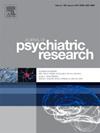两年内早期创伤后心率变异性与创伤后应激障碍的关系
IF 3.2
2区 医学
Q1 PSYCHIATRY
引用次数: 0
摘要
本研究通过为期两年的随访,探讨了早期损伤后心率变异性(HRV)测量与创伤后应激障碍(PTSD)发展之间的前瞻性关联。方法测量HRV基线参数,包括神经网络区间标准差(SDNN)、连续差均方根(RMSSD)、低频(LF)和高频(HF)频带、低频/高频比。还收集了社会人口统计学和临床协变量。在基线后3、6、12和24个月使用CAPS-5评估PTSD诊断。线性回归分析评估HRV参数与PTSD诊断之间的关系。结果538例患者中,58例(10.8%)被诊断为PTSD, 3个月时患病率为8.4%,6个月时为6.5%,12个月时为4.8%,24个月时为2.5%。较低的RMSSD和LF值预示着两年内的PTSD,在3个月和6个月的随访中具有显著的相关性。在3个月时,较低的HF值也与PTSD显著相关,在调整协变量和应用Bonferroni校正后,结果更为稳健。结论创伤事件后不久获得的hrv测量可作为创伤后应激障碍的预测性生物标志物,特别是在身体损伤后的前6个月内。本文章由计算机程序翻译,如有差异,请以英文原文为准。
Associations of heart rate variability at early post-injury with later post-traumatic stress disorder over two years
Background
This study examines the prospective associations between early post-injury heart rate variability (HRV) measures and post-traumatic stress disorder (PTSD) development over a two-year follow-up period.
Methods
Baseline HRV parameters were measured including the Standard Deviation of NN Intervals (SDNN), Root Mean Square of Successive Differences (RMSSD), Low Frequency (LF) and High Frequency (HF) bands, and LF/HF ratio. Socio-demographic and clinical covariates were also collected. PTSD diagnoses were assessed using CAPS-5 at 3, 6, 12, and 24 months post-baseline. Linear regression analyses evaluated the associations between HRV parameters and PTSD diagnoses.
Results
Among 538 patients analyzed, 58 (10.8 %) were diagnosed with PTSD, with prevalence rates of 8.4 % at 3 months, 6.5 % at 6 months, 4.8 % at 12 months, and 2.5 % at 24 months. Lower RMSSD and LF values predicted PTSD over two years, with significant associations at the 3- and 6-month follow-ups. Lower HF values were also significantly associated with PTSD at 3 months, findings robust after adjusting for covariates and applying Bonferroni corrections.
Conclusion
HRV measures obtained shortly after traumatic events can serve as predictive biomarkers for PTSD, particularly within the first 6 months following a physical injury.
求助全文
通过发布文献求助,成功后即可免费获取论文全文。
去求助
来源期刊

Journal of psychiatric research
医学-精神病学
CiteScore
7.30
自引率
2.10%
发文量
622
审稿时长
130 days
期刊介绍:
Founded in 1961 to report on the latest work in psychiatry and cognate disciplines, the Journal of Psychiatric Research is dedicated to innovative and timely studies of four important areas of research:
(1) clinical studies of all disciplines relating to psychiatric illness, as well as normal human behaviour, including biochemical, physiological, genetic, environmental, social, psychological and epidemiological factors;
(2) basic studies pertaining to psychiatry in such fields as neuropsychopharmacology, neuroendocrinology, electrophysiology, genetics, experimental psychology and epidemiology;
(3) the growing application of clinical laboratory techniques in psychiatry, including imagery and spectroscopy of the brain, molecular biology and computer sciences;
 求助内容:
求助内容: 应助结果提醒方式:
应助结果提醒方式:


